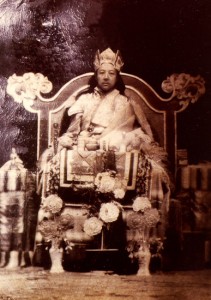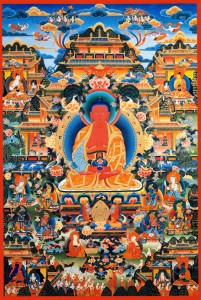The following is respectfully quoted from “Journey to Enlightenment” by His Holiness Dilgo Khyentse Rinpoche:
Khyentse Chökyi Lodrö asked Khyentse Rinpoche to go to Amdo province and give the Treasury of Rediscovered Teachings. Here is Rinpoche’s wife’s account of the journey:
Rinpoche traveled to Rekong, in Amdo, near Lake Kokonor. One very cold day, some herdsmen invited Rinpoche to their tent and offered them and his party a large quantity of butter, dried meat, and sweet cheese for the journey. Rinpoche usually warned one of his attendants to look after the horses carefully. When the time came to leave, the attendant rushed in exclaiming that the horses had disappeared; he had left them for a while and they must have been stolen. Fortunately, the herdsmen had many yaks and gave some to Rinpoche, who reached Rekong after a month’s journey.
In Rekong, Rinpoche gave the empowerments of the Treasury of Rediscovered Teachings over four months to 1,900 yogis. When Rinpoche’s hosts heard from his monks about the theft of his horses, they were quite upset; but Rinpoche told them that he had arrived safely and so it was now of no concern. However, some of the Rekong yogis, known for their magic power, said they could not just leave the matter like that. Two weeks after Rinpoche started teaching, the robbers arrived with all the stolen horses and begged Rinpoche to take them back. Rinpoche replied that he no longer needed the horses and they could keep them, but the robbers refused to listen. After the theft of the horses, they said, everything had gone wrong for them. When they milked their cows, they got not milk but blood. One boy had been attacked by vultures–something quite unheard of–and many of the clan had fallen ill. Finally, they just left the horses near the monastery and rode away.
Rinpoche stayed at Rekong monastery for a year, and gave teachings at a beautiful hilltop site where the famous nineteenth-century yogi Shabkar Tsogdruk Rangdrol had lived. There was a large rock, with a tree behind it, on which Shabkar use to sit and sing his famous spiritual songs. The local people offered this seat to Rinpoche, and when he improvised songs there, rainbows appeared and snowflakes fell gently, like flowers. Everyone said that he must be a reincarnation of Shabkar.
Rinpoche had an attendant, a ritual master called Achog, whom he often had to reprimand. One night Achog ran away, leaving a piece of cloth as an offering and a note saying that he felt unable to serve Rinpoche properly and had therefore decided to leave. After walking for a month, he reached a herdsmen’s camp in Golok, and in one of the black yak-hair tents a mother and daughter asked him to perform some ceremonies in exchange for food and lodging. It was freezing cold and he had nowhere else to go, so he agreed. By then he had fallen quite ill.
One day the mother called out to Achog that a stranger, a tall lama on a big horse, was approaching the tent. Achog looked through the door and saw Khyentse Rinpoche with an attendant riding straight up to the tent. Rinpoche dismounted, came in, and asked: “Achog, how are you?” Achog was so astounded that he began to cry. Rinpoche told him there was no need to cry and that he had better come back with them. The old mother offered Rinpoche tea, milk, and curd. In answer to Achog’s questions, Rinpoche’s attendant said that no one had told them where to find him; nor had they met anyone in the snow-covered landscape to give them directions to the camp. Rinpoche said it was time to go, and all three came back home together. In those days, people use to say Rinpoche had incredible clairvoyance.
On their travels they stopped at many pilgrimage sites and monasteries. Khyentse Rinpoche writes of one such occasion when he revealed one of his main spiritual treasures (terma), the Pema’s Heart Essence of Longevity cycle, which encompasses the whole spiritual path:
Stopping at Ladrö Monastery along the way, we went to the Gyamgyal Crystal Lotus Mountain, a pacifying holy site of the vajra family and one of the twenty-five important sacred places in Dokham. There we went to the Infant Milk Lake in front of Dothi Gangkar, where I made offerings to the local deities and performed the feast offering of Dharmakaya Master Amitayus from The Heart Practice Dispelling All Obstacles for a few days and even wrote a guidebook to the sacred place. There were many pilgrims at the light blue lake, and as the waves were stirred by the wind, a vivid pattern of a peaceful mandala complete with doors appeared on the lake, along with other auspicious signs. I also saw the Black Lake at Gyam and performed a feast offering. That night in a dream, I saw a text of The Nine Deities of Infinite Life in Jamyang Khyentse Wangpo’s handwriting. This appeared to me as a mind treasure, Pema’s Heart Essence of Longevity, which I wrote down.
His spouse, Khandro Lhamo, added to this:
Once, at the monastery called Karma Monastery, the seat of the first eight Karmapas, there was a very precious dharmaphala temple, which contained an image of Palden Lhamo and the protector Bernakchen in union. When the door of the room was opened, Khyentse Rinpoche saw Mahakala as if in reality and was given a yellow scroll–many people saw the scroll emerging from Palden Lhamo’s sleeve. The scroll contained dakini script for the Kilaya cycle according to Nyak Jnana Kumara’s tradition, which is one of Khyentse Rinpoche’s main spiritual treasures. Another time, Rinpoche went to Crystal Lotus Mountain, where he had a vision of Guru Padmasambhava in the form of Amitayus, the Buddha of Eternal Life, and received the mind treasure of Pema’s Heart Essence of Longevity. He received many termas in similar ways.
When recognizing a tulku, generally more than one Lama recognizes the tulku. In the case of Jetsunma Ahkon Lhamo, His Holiness Penor Rinpoche confirmed her recognition with Dilgo Khyentse Rinpoche, who was, at that time the Supreme Head of the Nyingma Tradition, and Second Dzongnang Jampal Lodro Rinpoche. Jetsunma received teachings from Dilgo Khyentse Rinpoche when visiting Nepal in 1987.


